Many of our customers wonder how to keep themselves safe while towing. Through this article, we will address some of the key issues associated with taking your RV on the road.
Mirrors:
Towing mirrors are a very important safety feature. Your mirrors should allow you to safely view your entire RV while towing and parking. This means you should be able to see both rear corners of your RV using your extension mirrors. Mirrors come in all price ranges and styles and some extension mirrors now come OEM on new trucks. If you are not fortunate enough to have extension mirrors as standard equipment on your vehicle, we will explain some options available to you.
Clip-On Mirrors:
Clip-on mirrors is often the most economical option available to RVers. These mirrors attach to your vehicle’s existing mirror using a rubber strap. They come in different mirror sizes allowing a varied viewing area, depending on the size of your RV. They are fully adjustable, and often fit vehicles that do not have the option of other types of tow mirrors (ie. slide on tow mirrors). However, sometimes these mirrors do not fit vehicles ideally and they also tend to vibrate while driving, making visibility poor sometimes.
Slide on Tow Mirrors:
This type of mirror is custom designed to fit your tow vehicle. They are a plastic molded mirror that slides over your existing mirror and fastens with a plastic wedge or hook. They are a sleeker looking mirror than the clip on style and tend to vibrate less. However, they are not available to fit all vehicles, especially less traditional tow vehicles (ie. cars). Also, they often offer a smaller overall mirror than other tow mirrors on the market.
Door Mount Mirrors:
Although these mirrors are more expensive than the two styles listed above, they offer some wonderful features that the other two types do not. We advise these mirrors for any serious RVer. These mirrors mount under your vehicle’s door and in your window well. They have a very large mirror face that is fully adjustable on a shaft that offers true extension. These mirrors do not require holes or drilling and set-up easily after your initial installation. Most importantly they do not vibrate.
There are many other mirror styles on the market. Available in manual or electric, some extension mirrors even replace your existing vehicle mirror. Please contact us if your have any questions or comments about tow mirrors.
Your Bearings On Your Towable RV:
Throughout this season, we have assisted with some serious bearing and brake issues that could have been easily avoided. There are a couple main culprits to these bearing disasters.
Bearing Buddies, Easy-Lube Axles & Over Greasing: The first problem is bearing buddies and easy-lube axles. These products allow you to add grease to your bearings by injecting it into a grease nipple that often replaces your hub cover. These products were designed for the marine industry for use on boat trailers and are not appropriate for RV’s. When you inject grease onto your bearing the extra grease has nowhere to go. When the grease heats up during travel it leaks onto your trailer brakes often damaging them beyond repair. The second problem is similar to the first, over greasing. Over greasing is just that, using too much grease when repacking your bearings. Like easy-lube axles and bearing buddies the results are the same, the excess grease can causes damage to your brakes. This can often result in brake loss and costly repairs.
Repacking Your Bearings:
According to Dexter Axle your bearings need to be repacked once a year or every 12, 000 miles, which ever comes first. If you choose to do this yourself, you should be careful not to over grease and to always use the correct fresh seals (we stock a large number of brake parts, including seals, magnets, springs and shoes). If you are not comfortable doing this work yourself, we would gladly do it for you. This bit of maintenance can save you time and money in the long haul.
Sway Controls and Weight Equalizing Hitches:
This section applies to those who are towing travel trailers. To clarify, we would like to explain the difference between a weight equalizing hitch and a sway control. These often causes a lot of confusion among customers. Except in unique circumstances the arms on your weight equalizing hitch do not act as a sway control. These arms help to distribute the weight of your travel trailer across the frame, so that all weight is not carried on the back of your vehicle but rather transferred across all axles. If you connect your travel trailer and the back of your vehicle drops significantly you should look into a weight equalizing hitch.
A sway control on the other hand, reduces sway while driving. Most people who tow find the existence of sway extremely uncomfortable and in some circumstances it can become dangerous. The general rule is trailers over 24’ require one sway control and those over 29’ require two. However some exception apply. Ask us for more information
Buyer Beware:
When choosing a weight equalizing hitch please note that the equalizing arms come in different weights (usually from 350lbs to 1200lbs). Although all of these hitches usually cost the same amount, please remember bigger does not necessarily mean better. These weights are optimized for the specification of your trailer. For example using heavier rated arms on your lightweight travel trailer can cause your trailer to skip across the road as you pull it (shaking up all your stuff and causing increased sway). This will make your vehicle harder to control while towing and put a tremendous amount of strain on the trailer itself. Conversely, if you chose to use lighter weighted arms on your heavy trailer you will not get the full benefits of an equalizer hitch. Let us help you choose the hitch necessary for your towing situation.
If you have any further questions about towing and towing safety feel free to message or call us.
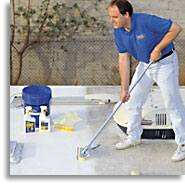
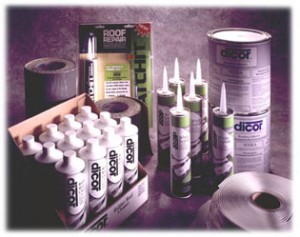
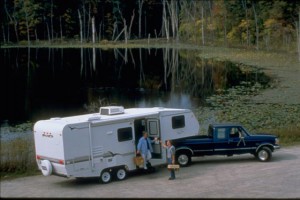
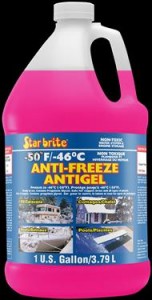
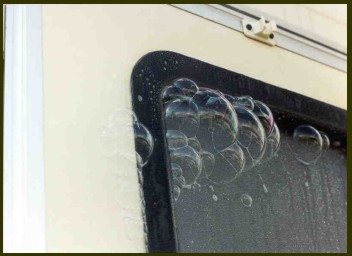
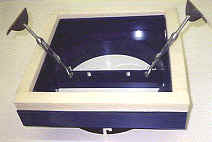

 The Cradle acts as a support for the awning while it is rolled up. Awnings over 16′ tend to become bowed in the center as a result of the weight of the roller assembly and the downward pull of gravity. The cradle will gently hold the awning in the center and help keep it straight over time. They are also very important for campers who take their RV on the road. Roads conditions tend to take their toll on awnings, causing them to bounce and develop a bow in the middle.
The Cradle acts as a support for the awning while it is rolled up. Awnings over 16′ tend to become bowed in the center as a result of the weight of the roller assembly and the downward pull of gravity. The cradle will gently hold the awning in the center and help keep it straight over time. They are also very important for campers who take their RV on the road. Roads conditions tend to take their toll on awnings, causing them to bounce and develop a bow in the middle.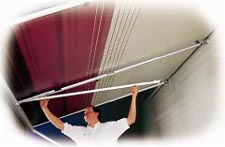 Please Note: Although many RVs come from the manufacturers with awnings larger than 16′ already installed, rarely do they come with a Center Rafter/Bar-to-Ground combination. This does not mean your awning would not benefit from this system and we recommend installing the A&E Optima system. This system contains a Cradle, Center Rafter and Bar-to-Ground Support that is nice to look at and easy to operate.
Please Note: Although many RVs come from the manufacturers with awnings larger than 16′ already installed, rarely do they come with a Center Rafter/Bar-to-Ground combination. This does not mean your awning would not benefit from this system and we recommend installing the A&E Optima system. This system contains a Cradle, Center Rafter and Bar-to-Ground Support that is nice to look at and easy to operate.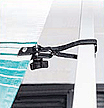 These are a relatively new product and are designed to help cut down on awning noise caused by fabric vibrations. They attach to the inner arm of your awning and then to the fabric. They help to hold the fabric in place in windy weather, and may ward off fabric tearing. These products have become so popular that awning manufactures like Carefree of Colorado are including them on some of their new roll-up awnings (The Carefree Fiesta and Spirit).
These are a relatively new product and are designed to help cut down on awning noise caused by fabric vibrations. They attach to the inner arm of your awning and then to the fabric. They help to hold the fabric in place in windy weather, and may ward off fabric tearing. These products have become so popular that awning manufactures like Carefree of Colorado are including them on some of their new roll-up awnings (The Carefree Fiesta and Spirit).